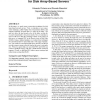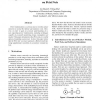684 search results - page 11 / 137 » Techniques for low energy software |
ICASSP
2010
IEEE
13 years 7 months ago
2010
IEEE
This contribution presents a wideband (50 Hz – 7 kHz) speech enhancement system that is operating in the frequency domain. As a novel feature, techniques known from artificial ...
RTAS
2006
IEEE
14 years 1 months ago
2006
IEEE
The evolution of battery technology is not being able to keep up with the increasing performance demand of mobile embedded systems. Therefore, battery life has become an important...
ICS
2004
Tsinghua U.
14 years 29 days ago
2004
Tsinghua U.
In this paper, we study energy conservation techniques for disk array-based network servers. First, we introduce a new conservation technique, called Popular Data Concentration (P...
MICRO
2009
IEEE
14 years 2 months ago
2009
IEEE
The phase-change random access memory (PRAM) technology is fast maturing to production levels. Main advantages of PRAM are non-volatility, byte addressability, in-place programmab...
ICPPW
2008
IEEE
14 years 2 months ago
2008
IEEE
Power minimization is a serious issue in wireless sensor networks to extend the lifetime and minimize costs. However, in order to gain an accurate understanding of issues regardin...


